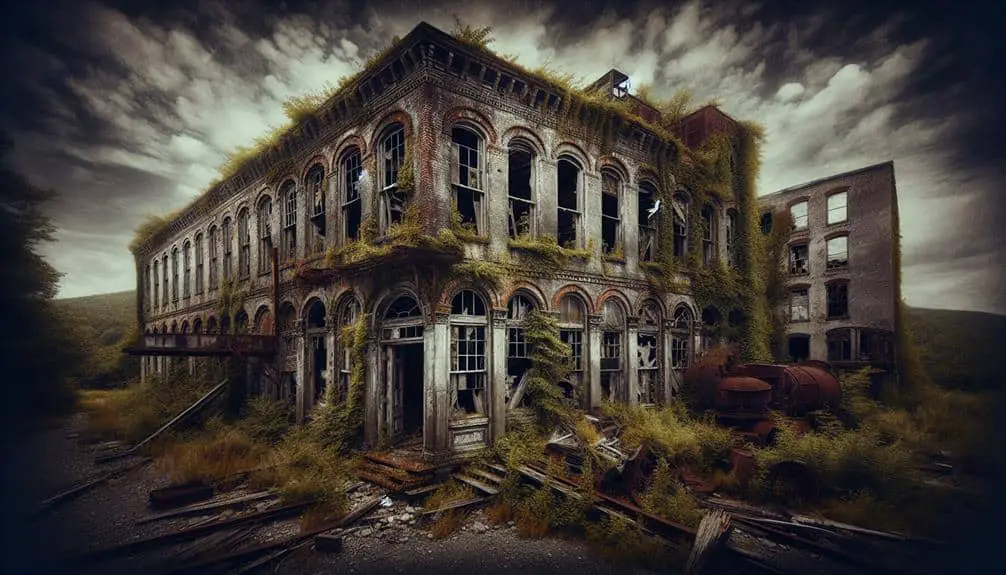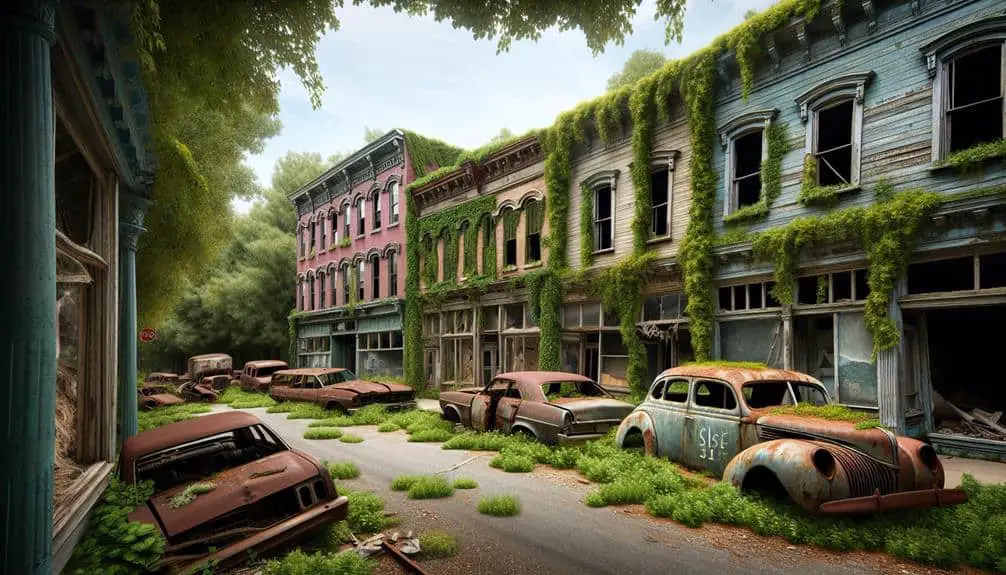Preserving forgotten post-apocalyptic ghost town structures is essential to safeguarding historical integrity and passing down tales of resilience. Decaying buildings whisper stories of past struggles, reminding us of impermanence. Challenges like environmental factors and structural instability demand careful upkeep. Techniques like advanced technologies and historical documentation aid in structural preservation. Community involvement and volunteer engagement play a pivotal role in restoration efforts. The future of ghost town conservation relies on strategic planning and innovative techniques. Discover how sustainable tourism and technological advancements are shaping the preservation of these abandoned places. Your interest in preservation can help protect these enduring remnants.
Key Points
- Utilize advanced technologies for structural assessment and preservation.
- Engage community in restoration efforts for long-term conservation.
- Implement sustainable tourism practices to protect abandoned sites.
- Document and evaluate building conditions using innovative tools like 3D scanning.
- Encourage respectful behavior from visitors to minimize impact on historical structures.
Importance of Preserving Ghost Town Ruins
Preserving ghost town ruins is essential for maintaining historical integrity and ensuring future generations understand the significance of these abandoned structures. The historical significance of these sites lies not only in their past glory but also in the stories they hold within their walls.
Each decaying building whispers tales of bygone eras, offering a glimpse into the lives of those who once inhabited them. The architectural decay present in these ruins serves as a poignant reminder of the passage of time and the impermanence of human endeavors.
Challenges in Maintaining Historic Structures
Maintaining historic structures poses significant challenges, particularly when faced with the relentless forces of nature and the inevitable decay that accompanies the passage of time. Historic materials, such as adobe, wood, and stone, are susceptible to environmental factors like moisture, sunlight, and temperature fluctuations. These elements can lead to erosion, rot, and structural instability, requiring vigilant upkeep to prevent irreversible damage.
Preservation efforts must contend with the delicate balance between conserving the importance of the original structures and implementing necessary repairs to secure their longevity. Striking this balance often involves meticulous research, careful planning, and skilled craftsmanship to maintain historical integrity while safeguarding against further deterioration. Additionally, the scarcity of traditional artisans trained in historical restoration techniques can present a significant obstacle in the preservation process.
Despite these challenges, the preservation of historic structures is vital in honoring the past and providing future generations with tangible connections to history. By acknowledging the complexities of maintaining these structures, we can work towards finding innovative solutions that respect the integrity of the past while adapting to the demands of the present.
Techniques for Structural Preservation
When considering techniques for structural preservation, one must prioritize the utilization of innovative methods to guarantee the longevity and integrity of historical buildings. Structural stabilization plays an important role in maintaining the original form and function of ghost town structures. This process involves evaluating the current condition of the building, identifying weak points, and implementing strategic reinforcements to prevent further deterioration. By employing advanced technologies like laser scanning and 3D modeling, experts can create detailed documentation of the building's existing state, aiding in the development of preservation strategies.
Historical documentation is another essential aspect of structural preservation. By meticulously recording the architectural features, materials used, and any unique characteristics of the building, historians can ensure that the structure's cultural significance is preserved for future generations. This information serves as a valuable resource for restoration efforts and helps maintain the authenticity of the ghost town structures. By combining structural stabilization with thorough historical documentation, we can safeguard these remnants of the past and keep their stories alive for years to come.
Community Involvement in Restoration Efforts
Community involvement plays a pivotal role in the restoration efforts of ghost town structures, fostering a sense of shared responsibility and connection to preserving our historical heritage. Volunteer engagement is a cornerstone of these restoration projects, drawing on the passion and dedication of individuals who are keen to contribute their time and skills to the cause. By actively participating in the restoration process, volunteers not only help to physically restore the structures but also become ambassadors for the preservation of these historical sites.
Local partnerships also play an essential role in engaging the community in restoration efforts. Collaborating with local businesses, organizations, and authorities can help raise awareness about the importance of preserving ghost town structures. These partnerships can also provide valuable resources, expertise, and support to ensure the success of restoration projects. By working together, communities can create a strong network of individuals and organizations dedicated to the preservation of our historical heritage.
Future of Ghost Town Conservation
To guarantee the long-term preservation of ghost town structures, strategic planning and innovative conservation techniques must be implemented. Sustainable tourism plays an important role in the future of ghost town conservation. By promoting responsible travel practices, we can make sure that these historical sites are protected for future generations to appreciate. Encouraging visitors to respect the environment and heritage of ghost towns will help minimize negative impacts on the structures.
Moreover, technological innovations offer exciting possibilities for the conservation of ghost town structures. Advanced imaging techniques such as 3D scanning and drones can aid in documenting and evaluating the condition of buildings, enabling preservationists to develop more targeted restoration plans. Virtual reality experiences can also provide immersive ways for people to explore these abandoned places without causing any physical harm to the fragile structures.
Frequently Asked Questions
Are There Any Legal Issues or Regulations That Need to Be Considered When Preserving Ghost Town Ruins?
When preserving ghost town ruins, remember to take into account legal issues and regulations. Environmental impact and historical significance must be respected. Property rights and public access are key factors to navigate for the preservation of these unique structures.
How Do You Determine Which Structures Are Worth Preserving and Which Ones Should Be Left to Decay?
You evaluate structures for preservation based on historical significance, aesthetic value, structural integrity, and cultural relevance. Deciding which to save and which to let decay involves understanding their impact, beauty, condition, and societal importance.
What Are Some Unique Preservation Challenges Specific to Post-Apocalyptic Ghost Town Structures?
When it comes to preservation challenges of post-apocalyptic ghost town structures, you'll face unique obstacles. Environmental impact can deteriorate these remnants faster. Understanding these challenges is essential for maintaining the history and stories they hold.
How Do You Address Potential Safety Concerns for Visitors Exploring These Abandoned Structures?
When exploring abandoned structures, prioritizing safety measures is essential. Guarantee visitors are equipped with protective gear, clear pathways, and warning signs. By balancing historical significance with safety, you create a space where curiosity thrives without compromising well-being.
Are There Any Innovative Technologies or Methods Being Used in the Preservation of Ghost Town Ruins That Are Not Commonly Known?
Innovative technological advancements like remote sensing are revolutionizing preservation methods for ghost town ruins. These tools help uncover hidden structures, preserving the cultural significance of these forgotten places for future generations to explore and appreciate.



